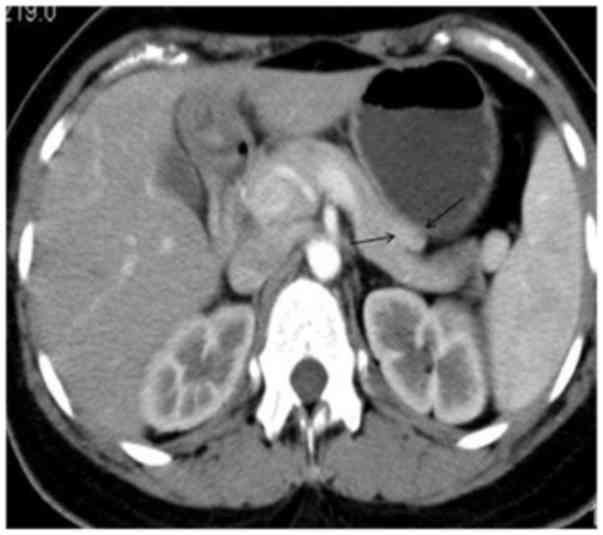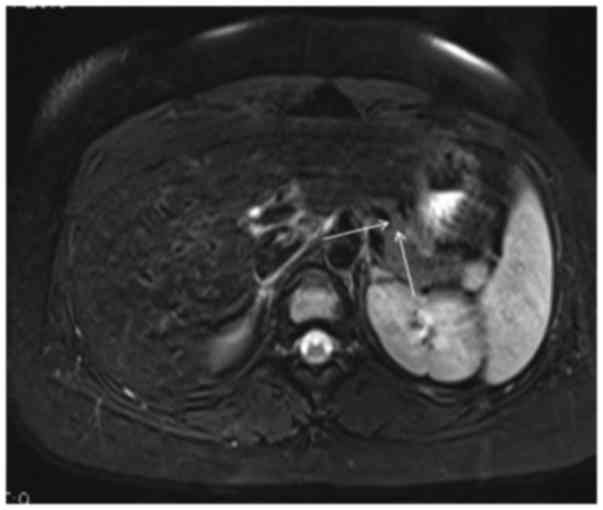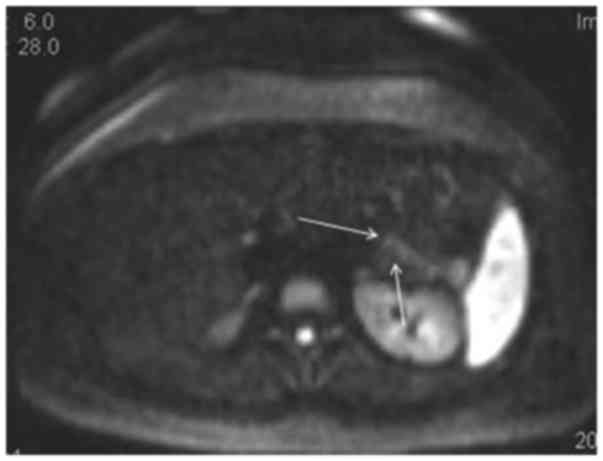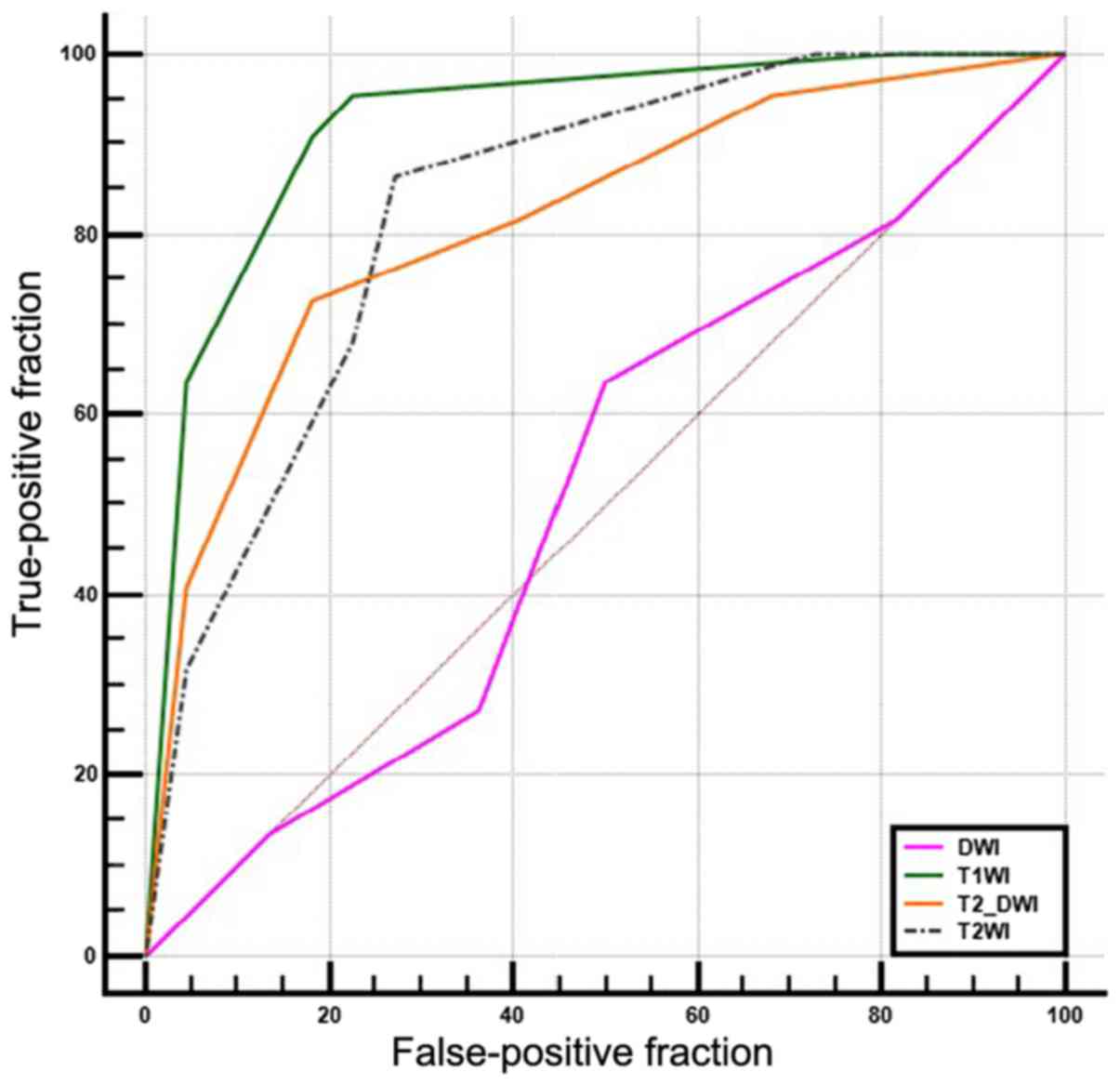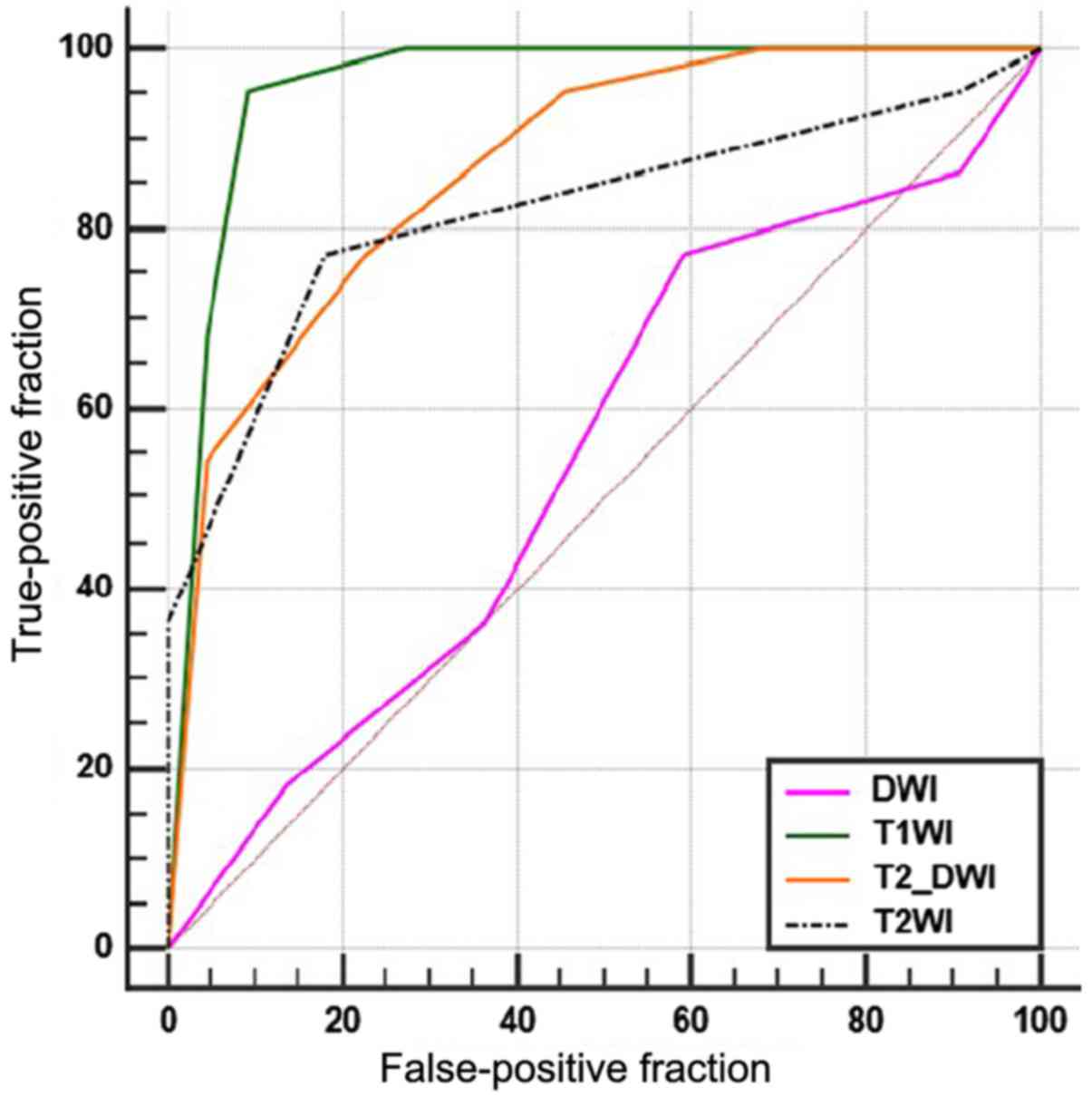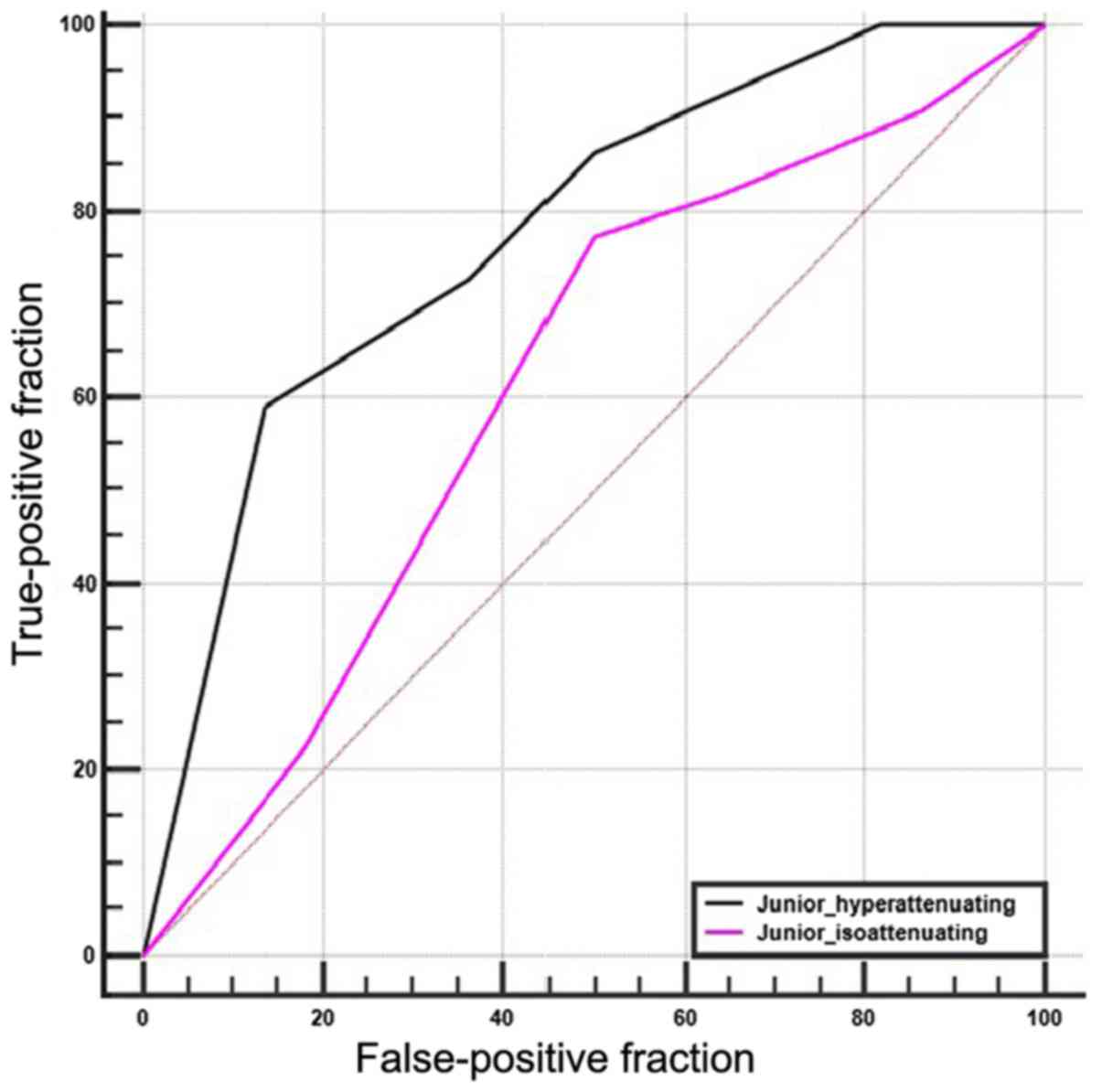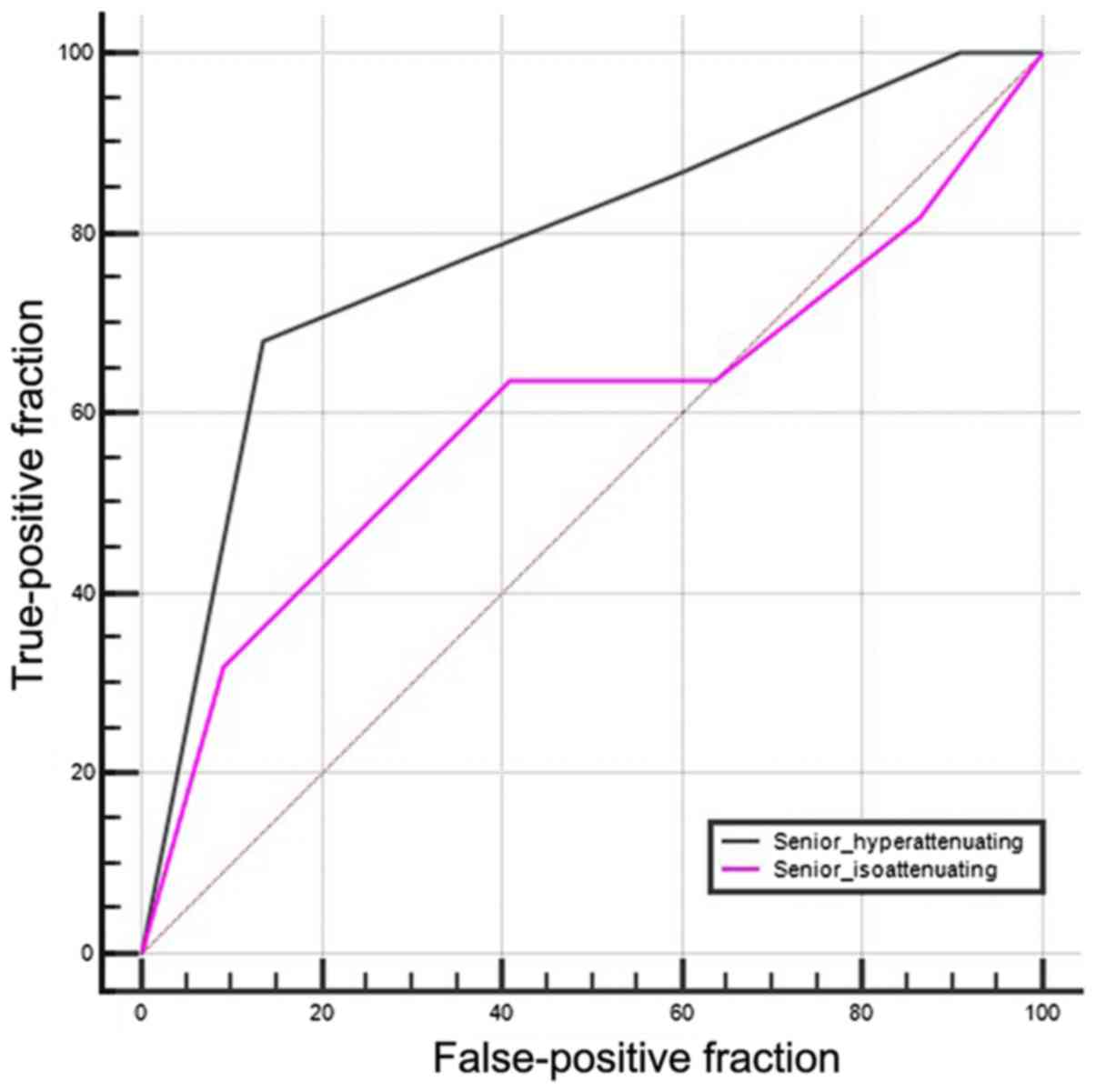|
1
|
Service FJ, McMahon MM, O'Brien PC and
Ballard DJ: Functioning insulinoma-incidence, recurrence, and
long-term survival of patients: A 60-year study. Mayo Clin Proc.
66:711–719. 1991. View Article : Google Scholar : PubMed/NCBI
|
|
2
|
Alessandrino F, Ivanovic AM, Yee EU,
Radulovic D, Souza D and Mortele KJ: MDCT and MRI of the ampulla of
Vater part I: Technique optimization, normal anatomy, and
epithelial neoplasms. Abdom Imaging. 40:3274–3291. 2015. View Article : Google Scholar : PubMed/NCBI
|
|
3
|
Anaye A, Mathieu A, Closset J, Bali MA,
Metens T and Matos C: Successful preoperative localization of a
small pancreatic insulinoma by diffusion-weighted MRI. JOP.
10:528–531. 2009.PubMed/NCBI
|
|
4
|
Mehrabi A, Fischer L, Hafezi M,
Dirlewanger A, Grenacher L, Diener MK, Fonouni H, Golriz M,
Garoussi C, Fard N, et al: A systematic review of localization,
surgical treatment options, and outcome of insulinoma. Pancreas.
43:675–686. 2014. View Article : Google Scholar : PubMed/NCBI
|
|
5
|
Bakir B, Salmaslioğlu A, Poyanli A,
Rozanes I and Acunas B: Diffusion weighted MR imaging of pancreatic
islet cell tumors. Eur J Radiol. 74:214–220. 2010. View Article : Google Scholar : PubMed/NCBI
|
|
6
|
Barral M, Taouli B, Guiu B, Koh DM,
Luciani A, Manfredi R, Vilgrain V, Hoeffel C, Kanematsu M and Soyer
P: Diffusion-weighted MR imaging of the pancreas: Current status
and recommendations. Radiology. 274:45–63. 2015. View Article : Google Scholar : PubMed/NCBI
|
|
7
|
Brenner R, Metens T, Bali M, Demetter P
and Matos C: Pancreatic neuroendocrine tumor: Added value of fusion
of T2-weighted imaging and high b-value diffusion-weighted imaging
for tumor detection. Eur J Radiol. 81:e746–e749. 2012. View Article : Google Scholar : PubMed/NCBI
|
|
8
|
Buetow PC, Parrino TV, Buck JL,
Pantongrag-Brown L, Ros PR, Dachman AH and Cruess DF: Islet cell
tumors of the pancreas: Pathologic-imaging correlation among size,
necrosis and cysts, calcification, malignant behavior, and
functional status. AJR Am J Roentgenol. 165:1175–1179. 1995.
View Article : Google Scholar : PubMed/NCBI
|
|
9
|
Caramella C, Dromain C, De Baere T, Boulet
B, Schlumberger M, Ducreux M and Baudin E: Endocrine pancreatic
tumors: Which are the most useful MRI sequences? Eur Radiol.
20:2618–2627. 2010. View Article : Google Scholar : PubMed/NCBI
|
|
10
|
Metz CE: Some practical issues of
experimental design and data analysis in radiological ROC studies.
Invest Radiol. 24:234–245. 1989. View Article : Google Scholar : PubMed/NCBI
|
|
11
|
Buchbender C, Hartung-Knemeyer V,
Beiderwellen K, Heusch P, Kühl H, Lauenstein TC, Forsting M, Antoch
G and Heusner TA: Diffusion-weighted imaging as part of hybrid
PET/MRI protocols for whole-body cancer staging: Does it benefit
lesion detection? Eur J Radiol. 82:877–882. 2013. View Article : Google Scholar : PubMed/NCBI
|
|
12
|
Daneshvar K, Grenacher L, Mehrabi A,
Kauczor HU and Hallscheidt P: Preoperative tumor studies using MRI
or CT in patients with clinically suspected insulinoma.
Pancreatology. 11:487–494. 2011. View Article : Google Scholar : PubMed/NCBI
|
|
13
|
Dixon E and Pasieka JL: Functioning and
nonfunctioning neuroendocrine tumors of the pancreas. Curr Opin
Oncol. 19:30–35. 2007. View Article : Google Scholar : PubMed/NCBI
|
|
14
|
Dromain C and Baudin E: Imaging strategy
for staging and follow-up of endocrine tumors. Bull Cancer.
93:1183–1189. 2006.(In French). PubMed/NCBI
|
|
15
|
España-Gómez MN, Velázquez-Fernández D,
Bezaury P, Sierra M, Pantoja JP and Herrera MF: Pancreatic
insulinoma: A surgical experience. World J Surg. 33:1966–1970.
2009. View Article : Google Scholar : PubMed/NCBI
|
|
16
|
Fattahi R, Balci NC, Perman WH, Hsueh EC,
Alkaade S, Havlioglu N and Burton FR: Pancreatic diffusion-weighted
imaging (DWI): Comparison between mass-forming focal pancreatitis
(FP), pancreatic cancer (PC), and normal pancreas. J Magn Reson
Imaging. 29:350–356. 2009. View Article : Google Scholar : PubMed/NCBI
|
|
17
|
Fujinaga Y, Lall C, Patel A, Matsushita T,
Sanyal R and Kadoya M: MR features of primary and secondary
malignant lymphoma of the pancreas: A pictorial review. Insights
Imaging. 4:321–329. 2013. View Article : Google Scholar : PubMed/NCBI
|
|
18
|
Herwick S, Miller FH and Keppke AL: MRI of
islet cell tumors of the pancreas. AJR Am J Roentgenol.
187:W472–W480. 2006. View Article : Google Scholar : PubMed/NCBI
|
|
19
|
Hiramoto JS, Feldstein VA, LaBerge JM and
Norton JA: Intraoperative ultrasound and preoperative localization
detects all occult insulinomas. Arch Surg. 136:1020–1025. 2001.
View Article : Google Scholar : PubMed/NCBI
|
|
20
|
Lotfalizadeh E, Ronot M, Wagner M, Cros J,
Couvelard A, Vullierme MP, Allaham W, Hentic O, Ruzniewski P and
Vilgrain V: Prediction of pancreatic neuroendocrine tumour grade
with MR imaging features: Added value of diffusion-weighted
imaging. Eur Radiol. 27:1748–1759. 2017. View Article : Google Scholar : PubMed/NCBI
|
|
21
|
Ichikawa T, Peterson MS, Federle MP, Baron
RL, Haradome H, Kawamori Y, Nawano S and Araki T: Islet cell tumor
of the pancreas: Biphasic CT versus MR imaging in tumor detection.
Radiology. 216:163–171. 2000. View Article : Google Scholar : PubMed/NCBI
|
|
22
|
Inan N, Arslan A, Akansel G, Okay E and
Gurbuz Y: Unusual magnetic resonance image of an insulinoma with
extensive desmoplastic reaction. JOP. 9:61–66. 2008.PubMed/NCBI
|
|
23
|
Kim JH, Park SH, Yu ES, Kim MH, Kim J,
Byun JH, Lee SS, Hwang HJ, Hwang JY, Lee SS and Lee MG: Visually
isoattenuating pancreatic adenocarcinoma at dynamic-enhanced CT:
Frequency, clinical and pathologic characteristics, and diagnosis
at imaging examinations. Radiology. 257:87–96. 2010. View Article : Google Scholar : PubMed/NCBI
|
|
24
|
Zhu L, Xue HD, Sun H, Wang X, He YL, Jin
ZY and Zhao YP: Isoattenuating insulinomas at biphasic
contrast-enhanced CT: Frequency, clinicopathologic features and
perfusion characteristics. Eur Radiol. 26:3697–3705. 2016.
View Article : Google Scholar : PubMed/NCBI
|
|
25
|
Lee EK, Yun TJ, Kim JH, Lee KE, Kim SJ,
Won JK, Kang KM, Choi SH and Sohn CH: Effect of tumor volume on the
enhancement pattern of parathyroid adenoma on parathyroid
four-dimensional CT. Neuroradiology. 58:495–501. 2016. View Article : Google Scholar : PubMed/NCBI
|
|
26
|
Lee SS, Byun JH, Park BJ, Park SH, Kim N,
Park B, Kim JK and Lee MG: Quantitative analysis of
diffusion-weighted magnetic resonance imaging of the pancreas:
Usefulness in characterizing solid pancreatic masses. J Magn Reson
Imaging. 28:928–936. 2008. View Article : Google Scholar : PubMed/NCBI
|
|
27
|
Klimstra DS, Modlin IR, Coppola D, Lloyd
RV and Suster S: The pathologic classification of neuroendocrine
tumors: A review of nomenclature, grading, and staging systems.
Pancreas. 39:707–712. 2010. View Article : Google Scholar : PubMed/NCBI
|
|
28
|
Klöppel G, Rindi G, Perren A, Komminoth P
and Klimstra DS: The ENETS and AJCC/UICC TNM classifications of the
neuroendocrine tumors of the gastrointestinal tract and the
pancreas: A statement. Virchows Arch. 456:595–597. 2010. View Article : Google Scholar : PubMed/NCBI
|
|
29
|
Zhu L, Xue H, Sun H, Wang X, Wu W, Jin Z
and Zhao Y: Insulinoma detection with MDCT: Is there a role for
whole-pancreas perfusion? AJR Am J Roentgenol. 208:306–314. 2017.
View Article : Google Scholar : PubMed/NCBI
|
|
30
|
Liu Y, Song Q, Jin HT, Lin XZ and Chen KM:
The value of multidetector-row CT in the preoperative detection of
pancreatic insulinomas. Radiol Med. 114:1232–1238. 2009. View Article : Google Scholar : PubMed/NCBI
|
|
31
|
Machado MC, da Cunha JE, Jukemura J,
Bacchella T, Penteado S, Abdo EE, Machado MA, Herman P, Montagnini
AL and Pinotti H: Insulinoma: Diagnostic strategies and surgical
treatment. A 22-year experience. Hepatogastroenterology.
48:854–858. 2001.PubMed/NCBI
|
|
32
|
Matsuki M, Inada Y, Nakai G, Tatsugami F,
Tanikake M, Narabayashi I, Masuda D, Arisaka Y, Takaori K and
Tanigawa N: Diffusion-weighed MR imaging of pancreatic carcinoma.
Abdom Imaging. 32:481–483. 2007. View Article : Google Scholar : PubMed/NCBI
|
|
33
|
Menegaux F, Schmitt G, Mercadier M and
Chigot JP: Pancreatic insulinomas. Am J Surg. 165:243–248. 1993.
View Article : Google Scholar : PubMed/NCBI
|
|
34
|
Murakami K, Nawano S, Moriyama N and Onuma
Y: Usefulness of magnetic resonance imaging with dynamic contrast
enhancement and fat suppression in detecting a pancreatic tumor.
Jpn J Clin Oncol. 28:107–111. 1998. View Article : Google Scholar : PubMed/NCBI
|
|
35
|
Noone TC, Hosey J, Firat Z and Semelka RC:
Imaging and localization of islet-cell tumours of the pancreas on
CT and MRI. Best Pract Res Clin Endocrinol Metab. 19:195–211. 2005.
View Article : Google Scholar : PubMed/NCBI
|
|
36
|
Ramsay D, Gibson P, Edmunds S and
Mendelson R: Pancreatic islet cell tumours presenting as recurrent
acute pancreatitis: Imaging features in three cases. Australas
Radiol. 45:520–523. 2001. View Article : Google Scholar : PubMed/NCBI
|
|
37
|
Rha SE, Jung SE, Lee KH, Ku YM, Byun JY
and Lee JM: CT and MR imaging findings of endocrine tumor of the
pancreas according to WHO classification. Eur J Radiol. 62:371–377.
2007. View Article : Google Scholar : PubMed/NCBI
|
|
38
|
Sheth S and Fishman EK: Imaging of
uncommon tumours of the pancreas. Radiol Clin North Am.
40:1273–1287. 2002. View Article : Google Scholar : PubMed/NCBI
|
|
39
|
Thoeni RF, Mueller-Lisse UG, Chan R, Do NK
and Shyn PB: Detection of small, functional islet cell tumors in
the pancreas: Selection of MR imaging sequences for optimal
sensitivity. Radiology. 214:483–490. 2000. View Article : Google Scholar : PubMed/NCBI
|
|
40
|
Toshima F, Inoue D, Komori T, Yoshida K,
Yoneda N, Minami T, Matsui O, Ikeda H and Gabata T: Is the
combination of MR and CT findings useful in determining the tumor
grade of pancreatic neuroendocrine tumors? Jpn J Radiol.
35:242–253. 2017. View Article : Google Scholar : PubMed/NCBI
|
|
41
|
Wang Y, Chen ZE, Yaghmai V, Nikolaidis P,
McCarthy RJ, Merrick L and Miller FH: Diffusion-weighted MR imaging
in pancreatic endocrine tumors correlated with histopathologic
characteristics. J Magn Reson Imaging. 33:1071–1079. 2011.
View Article : Google Scholar : PubMed/NCBI
|
|
42
|
Wang Y, Miller FH, Chen ZE, Merrick L,
Mortele KJ, Hoff FL, Hammond NA, Yaghmai V and Nikolaidis P:
Diffusion-weighted MR imaging of solid and cystic lesions of the
pancreas. Radiographics. 31:E47–E64. 2011. View Article : Google Scholar : PubMed/NCBI
|
|
43
|
Yao XZ, Yun H, Zeng MS, Wang H, Sun F, Rao
SX and Ji Y: Evaluation of ADC measurements among solid pancreatic
masses by respiratory-triggered diffusion-weighted MR imaging with
inversionrecovery fat-suppression technique at 3.0T. Magn Reson
Imaging. 31:524–528. 2013. View Article : Google Scholar : PubMed/NCBI
|
|
44
|
Ye XH, Gao JY, Yang ZH and Liu Y: Apparent
diffusion coefficient reproducibility of the pancreas measured at
different MR scanners using diffusion-weighted imaging. J Magn
Reson Imaging. 40:1375–1381. 2014. View Article : Google Scholar : PubMed/NCBI
|
|
45
|
Yoshikawa T, Kawamitsu H, Mitchell DG,
Ohno Y, Ku Y, Seo Y, Fujii M and Sugimura K: ADC measurement of
abdominal organs and lesions using parallel imaging technique. AJR
Am J Roentgenol. 187:1521–1530. 2006. View Article : Google Scholar : PubMed/NCBI
|
|
46
|
Zhang TP, Zhao YP, Cong L, Liao Q, Dai MH
and Guo JC: Noninvasive examinations for localization of
insulinoma. Zhonghua Wai Ke Za Zhi. 47:1365–1367. 2009.(In
Chinese). PubMed/NCBI
|
|
47
|
Zhao YP, Zhan HX, Zhang TP, Cong L, Dai
MH, Liao Q and Cai LX: Surgical management of patients with
insulinomas: Result of 292 cases in a single institution. J Surg
Oncol. 103:169–174. 2011. View Article : Google Scholar : PubMed/NCBI
|
|
48
|
Zhu L, Xue H, Sun Z, Li P, Qian T, Xing X,
Li N, Zhao Y, Wu W and Jin Z: Prospective comparison of biphasic
contrast-enhanced CT, volume perfusion CT, and 3 Tesla MRI with
diffusion-weighted imaging for insulinoma detection. J Magn Reson
Imaging. 46:1648–1655. 2017. View Article : Google Scholar : PubMed/NCBI
|
|
49
|
Rosenkrantz AB, Oei M, Babb JS, Niver BE
and Taouli B: Diffusion-weighted imaging of the abdomen at 3.0
Tesla: Image quality and apparent diffusion coefficient
reproducibility compared with 1.5 Tesla. J Magn Reson Imaging.
33:128–135. 2011. View Article : Google Scholar : PubMed/NCBI
|



